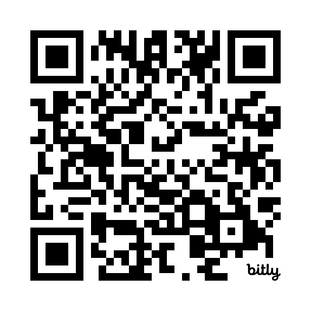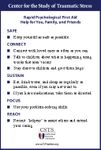Hurricane Helene Disaster Mental Health Response and Recovery Resources
Catastrophic natural disasters, such as Hurricane Helene, cause extreme disruption and can be stressful for individuals, families, and communities. Below are brief, action-oriented fact sheets and additional information to help individuals, communities, and organizations in the aftermath of Hurricane Helene.
Free interactive, online training in protecting mental health and fostering resilience after disasters can be accessed here. A free resource for learning about disaster mental health and developing education resources can be found here.
Use this QR code to share this webpage

POCKET CARDS
|
Rapid Psychological First Aid: |
Click HERE for all versions of Rapid Psychological First Aid: Help for You, Family, and Friends
Click HERE for all versions of Helping Others Calm an Acute Stress Response
RESOURCES FOR FAMILIES:
RESOURCES FOR HEALTHCARE PERSONNEL:
RESOURCES FOR LEADERS:
Common responses to disasters include distress reactions (insomnia, irritability, loss of safety, social isolation, blaming and scapegoating) and health risk behaviors (increased use of alcohol and tobacco, reduced attention to health and family needs). For supervisors, leaders, family members, and healthcare personnel, being alert to these reactions and behaviors, promptly identifying them, and providing interventions can reduce distress and improve functioning, and may decrease the likelihood of developing mental disorders. Normalizing the reactions and offering guidance about what to expect with symptoms over time, as well as when and where to get assistance if needed, helps people feel calm and increases self-reliance. Anxiety about the future is best managed through “problem solving” and supporting people in connecting with practical help when available. Displacement, loss of support systems, and home damage are all common problems caused by hurricanes. Assisting people in addressing these challenges will help lower distress and foster recovery. The following resource(s) address this topic in further detail:
Helping Communities After Disasters
Grief is a near universal experience for those directly impacted by an extreme disaster, such as hurricanes. In the immediate aftermath of hurricanes, loss of life, as well as homes, possessions (such as pictures, keepsakes and other items which comprise our lives), sense of safety, and life routine cause feelings of grief. Community leaders, disaster managers, and healthcare providers can help those affected by proactively and respectfully inquiring about, acknowledging, and then allowing individuals to process grief. Grief support also involves addressing feelings of loss, mourning losses, and acknowledging fears about the future. Be sensitive to the need for rituals, such as memorial and funerals, to support expressions of grief, which promote healing and strengthen communities. The following resource(s) address this topic in further detail:
Grief Leadership in the Wake of Tragedies
Leadership in Disasters & Lessons Learned
Evacuation centers and shelter facilities are often needed to house those displaced after hurricanes. Those working in any form of evacuation center or shelter can support mental health and wellbeing of community members through interventions consistent with the principles of Psychological First Aid (PFA), which involves enhancing a sense of safety, calming, self- and community-efficacy (reliance), social connectedness, and hope or optimism. Interventions at evacuation centers which promote PFA principles include: calming through reducing exposure to media and optimizing sleep, keeping children connected with primary caregivers and accommodating pets when possible, and facilitating processes that create a sense of routine and control. In addition, creating “communities” helps encourage formal and informal support. Promoting calm may mean helping those in significant distress through one-on-one interactions, as having residents retell their distressing stories in great detail may unnecessarily increase distress in those with less exposure. Creating and maintaining connections with healthcare support systems promotes a sense of safety by addressing acute (lost medications, active illnesses, etc.) and chronic (insulin for diabetes, dialysis for kidney disease, etc.) health concerns.
Vulnerable populations may be at increased risk for adverse mental health effects after a disaster and warrant unique considerations. Children have developmental limitations in their understanding and ability to respond and are also impacted by the distractions that typically occur for parents who are responding to a crisis. Cognitive and mobility impairment, as well as dependence on system of care can make it more difficult to evacuate or receive care when infrastructure is damaged, or healthcare systems become unavailable. First responders and public health emergency workers (including volunteers) who are directly impacted may have added stressors, in addition to job-related exposures to human remains and extreme suffering. Marginalized population (low socioeconomic status, migrants and refugees, LGBTQ persons, racial and ethnic minorities) may have limited access to resources, previous negative experiences using government services, and fear retaliation or reprisals, reducing access to critical post-disaster resources. Interventions that address the unique needs of populations at increased risk can reduce barriers to care. The following resource(s) address this topic in further detail:
Supporting Those with Pre-Existing Mental Health Conditions
How Families Can Help Children
First Responders, Emergency Workers & Volunteers and Exposure to Human Remains
Maintaining the Well-Being of Healthcare Providers
Health risk and crisis communication is a critical behavioral health intervention following a community disaster. For those leading disaster management efforts, understanding what to say and what not to say, when and how to say it are important elements. Basic principles include being clear and succinct, stating what is known and unknown, indicating when you do not know the answer, committing to following up at a specific time and then doing so, and avoid misleading or efforts to be overly reassuring as these erode trust. Effective communication following a disaster can reduce distress and enhance well-being for affected communities. The following resource(s) address this topic in further detail:
Risk and Crisis Communication for Leaders
Workplace management following a disaster is an important part of restoring community functioning. In addition to financial support, the workplace often provides a sense of meaning and social connectedness. Though workplaces may be understaffed during disasters, overworking remaining personnel leads to diminished functioning and demoralization. Effective support for personnel in the workplace can enhance functioning for both the individuals and the organization. The following resource(s) address this topic in further detail:
Workplace and Organization Management After Disaster
Additional Resources
Additional free fact sheet resources at the Center for the Study of Traumatic Stress
USA - Disasters and emergencies
National Hurricane Center: Hurricane Preparedness
Ready.gov Hurricane Preparedness
Disaster Psychiatry; What Psychiatrists Need to Know (T Ng)
Textbook of Disaster Psychiatry, 2nd Edition
Disaster Psychiatry (F Stoddard)
Resiliency in the Face of Disaster and Terrorism (J Napoli)
Integrating Emergency Management and Disaster Behavioral Health








